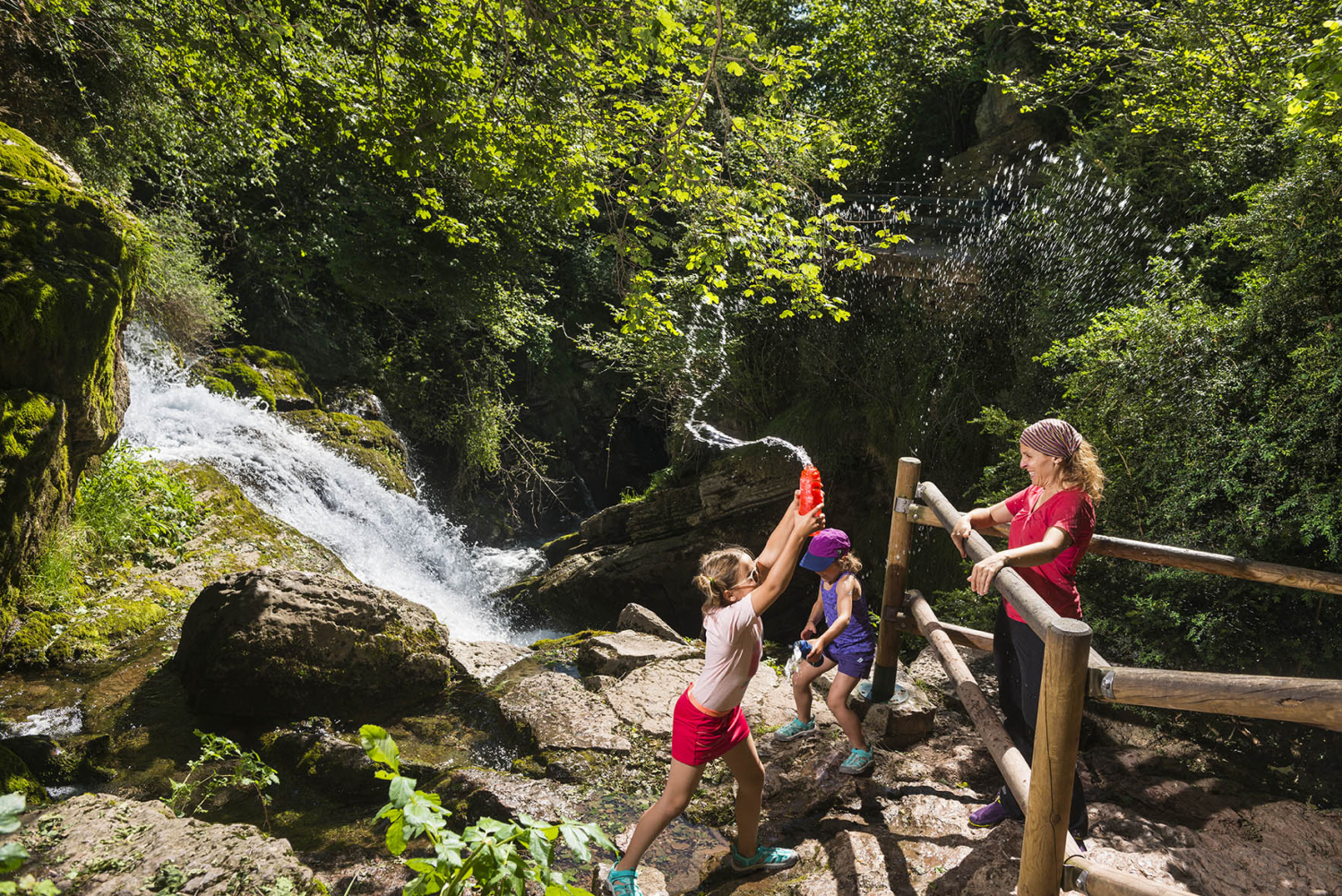
Les fonts del Llobregat i el pas de l'Ós
The Llobregat is born under the village of Castellar de n'Hug, where the rainwater (water and snow) collected in the basin that generates between the mountains of Puigllançada and Pleta Roja come to the surface. Waters that travel inside the karst aquifer excavated in the limestones of this area and come out in contact with a layer of waterproof material. It is a spectacle to see them coming out of the mountain, forming the Fonts del Llobregat.
In this short itinerary, the great weight falls on the natural environment of this beginning of the river - where there is also a place where the river gets worse, the Salt de l'Os - but also on many other anthropic ingredients: ancient mills, Forges, a Romanesque bridge, a Romanesque church and a neo-Romanesque church, and the Asland Cement Factory in Clot del Moro, one of the most incredible factory complexes in Catalan industrialization, which has now become a museum.
Description
The route begins at the town hall square of Castellar de n'Hug to the south, following the signs of the Camí del Llobregat (GR 270). Immediately a few steps go down to the municipal car park and on the left the Camí de les Fonts begins. It is a well-aligned path, delimited by wooden railings in many sections, with a series of information panels with data from the Llobregat, some benches, etc ... After a few turns you will start to feel the water. You will pass by the stream that you have to cross and the Fonts del Llobregat, and you can approach the source. You will climb a little and pass through the Mirador de les Fonts, a small balcony from which you can see the power of the water when leaving inside the mountain - of very variable flow depending on the time of year. You will keep going down and you will soon come to a track. Just before you look there is the first channel of the river. Go down the track on the left passing the Molí d'Orrols, the first mill that took advantage of the force of the water. If you look to the right, there is a large pipe that you will find along the way, it is the water conduction (in underground sections) that goes to the Clot del Moro where the cement factory was located, at the end of it. itinerary.
You will come to a crossroads of tracks and paths, you must continue on the lower right and then you will arrive at Hostal les Fonts, a small mountain hostel. You can approach the recreation area behind and you will see the Pont de la Farga Vella del s. XIV-XV, now boxed between the inn and the road. The name of Old Forge comes to him because a few meters below the river there was the first forge on the river, now only a few debris remain and it is difficult to access.
Cross the road and continue along the path that goes out in front of the inn, down the left bank. Here the path goes a bit further away from the river to meet again later when it joins the Beneta stream. You will pass by a pool and further down a more open area where if you look a little you will find the ruins of the old Rus-Forge Mill, which worked according to the time as a mill or forge. You will exit on a track that you have to follow to the right to cross the river over the bridge of Sant Vicenç where you will see again the Clot del Moro canal and a little further on a path to the right will take you to the church of Sant Vicenç de Russian (11th and 12th centuries). Continue on the left passing the house of La Farga and on the right you will find a path that will lower you at the foot of the stream. After crossing the lever, this time you will pass under the water conduit and connect with a track where the Gavarrós path comes. Continue downhill and shortly after passing through a porch you will leave it on a wide path to the right. A good stretch is waiting for you in the woods on the river.
You will arrive at a point where you need to save some stones, you are arriving at the Pas de l'Os. In all this section the precaution must be extreme, the land asks. You will pass over the waterfall that generates this cork, a place of special charm. The path continues through the forest, opening slightly in a section until you reach a forest track again. Follow it to the right up, to find the road to La Pobla de Lillet. A few meters below, you will find the paved access road to Clot del Moro on the right. Follow it and you will soon find buildings in this old industrial complex in Clot del Moro. Before making a steep descent to the right, there is a neo-Romanesque chapel, built by the cement engineer, between 1924 and 1926, at a time when the dependencies of the big factory.
The route ends in front of the spectacular building of the old Asland Cement factory in Clot del Moro, which was started by Eusebi Güell in the early s. XX being the first plant to obtain portland cement in the Iberian Peninsula. Today, part of the building has been converted into the Cement Museum.
Technical sheet
Route number: 28
Town: Castellar de n'Hug
Type: Very easy
Distance: 6 Km
Time: 1,5 h.
maximum altitude: 1386 m.
height difference: 125 m.
To organise
Cartography: 46-Parc Natural del Cadí-Moixeró E. 1:25.000. Institut Cartogràfic i Geològic de Catalunya Montgrony-Fonts del Llobregat 1:25.000. Ed. Alpina
More information
Bibliography: Inventari de Patrimoni: invarquit.cultura.gencat.cat Civitas Cultura: www.civitascultura.org Museu del Ciment: www.museuciment.cat/ Tren del Ciment: www.trendelciment.cat
Documents and links
- Les fonts del Llobregat i el pas de l'Os GPX 2020
- Les fonts del Llobregat i el pas de l'Os EARTH 2020
OFICINA DE TURISME DEL BERGUEDÀ
Carretera C16 Km 96
08600-Berga. Phone (+34) 654 125 696
Monday to Friday: 9 to 14h.
Saturday: 10 to 14 & 16 to 18h.
Sunday and holidays: 10 to 14h.
E-mail: turisme@elbergueda.cat
[Premsa]
Other

 English
English Follow us
Follow us







![[Tancar]](/plantilles/bergueda/img/tancar.png)














